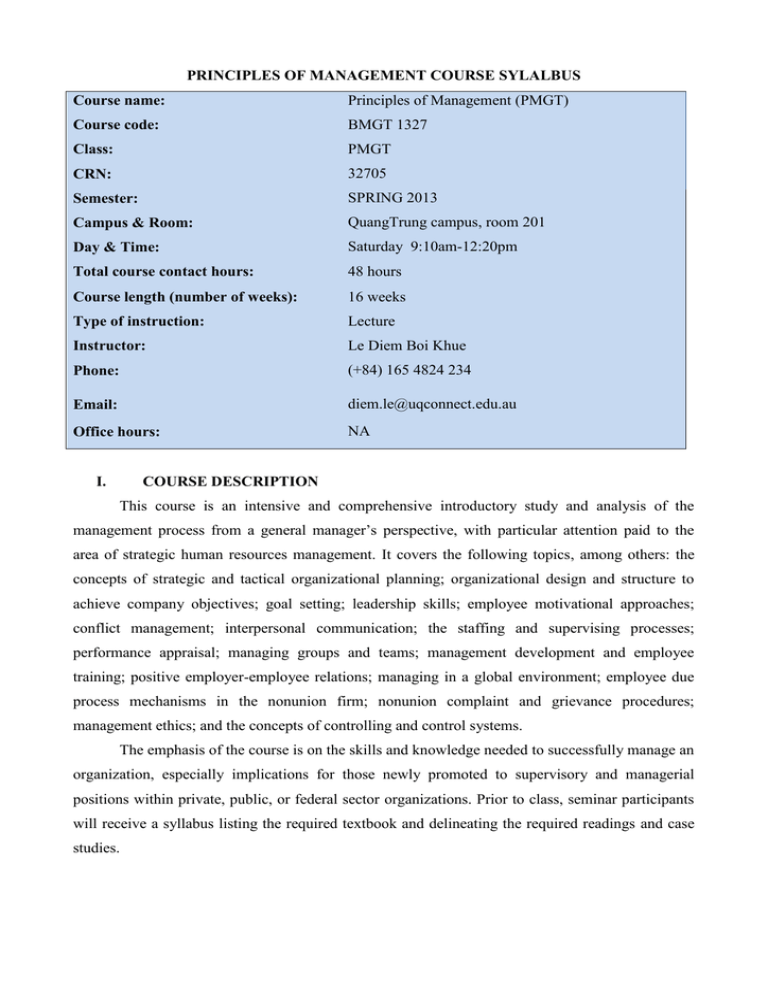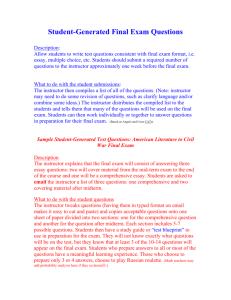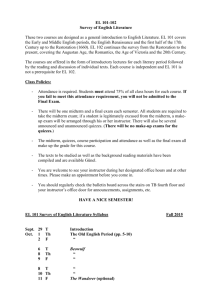
PRINCIPLES OF MANAGEMENT COURSE SYLALBUS
Course name:
Principles of Management (PMGT)
Course code:
BMGT 1327
Class:
PMGT
CRN:
32705
Semester:
SPRING 2013
Campus & Room:
QuangTrung campus, room 201
Day & Time:
Saturday 9:10am-12:20pm
Total course contact hours:
48 hours
Course length (number of weeks):
16 weeks
Type of instruction:
Lecture
Instructor:
Le Diem Boi Khue
Phone:
(+84) 165 4824 234
Email:
diem.le@uqconnect.edu.au
Office hours:
NA
I.
COURSE DESCRIPTION
This course is an intensive and comprehensive introductory study and analysis of the
management process from a general manager’s perspective, with particular attention paid to the
area of strategic human resources management. It covers the following topics, among others: the
concepts of strategic and tactical organizational planning; organizational design and structure to
achieve company objectives; goal setting; leadership skills; employee motivational approaches;
conflict management; interpersonal communication; the staffing and supervising processes;
performance appraisal; managing groups and teams; management development and employee
training; positive employer-employee relations; managing in a global environment; employee due
process mechanisms in the nonunion firm; nonunion complaint and grievance procedures;
management ethics; and the concepts of controlling and control systems.
The emphasis of the course is on the skills and knowledge needed to successfully manage an
organization, especially implications for those newly promoted to supervisory and managerial
positions within private, public, or federal sector organizations. Prior to class, seminar participants
will receive a syllabus listing the required textbook and delineating the required readings and case
studies.
II.
INSTRUCTIONAL MATERIALS
Text:Hill, C. W., &McShane, S. (2008). Principles of Management (international edn.). New York,
NY: The McGraw-Hill Companies, Inc.
Recommended Reading
Jones, G. R. (2007). Organizational Theory, Design, and Change (5th Ed.). Pearson Prentice Hall.
Wheelen, T. L., & Hunger, J. D. (2006).
Strategic Management and Business Policy: Concepts and Cases (10th Ed.). New Jersey: Pearson
Prentice Hall.
III.
END-OF-COURSE OUTCOMES
Understand principles of management through the concepts of strategic and tactical
organizational planning; organizational design and structure to achieve company objectives; goal
setting; leadership skills; employee motivational approaches; conflict management; interpersonal
communication; the staffing and supervising processes; performance appraisal; managing groups
and teams; management development and employee training; positive employer-employee
relations; managing in a global environment; employee due process mechanisms in the nonunion
firm; nonunion complaint and grievance procedures; management ethics; and the concepts of
controlling and control systems.
IV.
STUDENT LEARNING OUTCOMES (SLO) AND LEARNING OBJECTIVES
(LO)
Student Learning
Learning Objectives (LO)
Outcomes (SLO)
1. Explain and apply the
1.1. Describe the basic functions of management.
various theories,
1.2. Identify where in an organization managers are located.
processes, and
1.3. Discuss the challenges people encounter as they become first-time
functions of
management.
managers.
1.4. Describe the roles managers adopt to perform the basic functions of
management.
1.5. Identify stakeholders in an organization.
1.6. Explain what managers can do to behave in s socially responsible
manner.
1.7. Describe the different levels of planning in an organization.
1.8. Explain the difference between strategic, tactical, operating, and unit
plans.
1.9. Outline the value of single-use plans, standing plans, and contingency
plans.
1.10. Describe the main components of a typical strategic planning system.
1.11. Identify the main pitfalls that managers encounter when engaged in
formal planning process.
1.12. Define strategy.
1.13. Explain why the goal of strategy is to attain superior performance.
1.14. Describe what is meant by competitive advantage.
1.15. Explain how business-level strategy can lead to competitive
advantage.
1.16. Explain how corporate-level strategy can lead to competitive
advantage.
1.17. Explain what is meant by organization architecture.
1.18. Explain the advantages and disadvantages of centralization and
decentralization.
1.19. Discuss the pros and cons of tall versus flat structures.
1.20. Outline the different kinds of structure a firm can operate within and
explain how strategy could determine structure.
1.21. Discuss the attributes of a typical organizational control system.
1.22. Describe the different kinds of controls that are used in organizations.
1.23. Explain how different controls should be matched to the strategy and
structure of an organization.
1.24. Outline the features of the balance scorecard approach.
1.25. Discuss informal or backchannel control methods.
1.26. Define teams and discuss their benefits and limitations.
1.27. Discuss the success factors for self-directed teams.
1.28. Outline the model of team effectiveness.
1.29. Explain the influence on team effectiveness of a team’s task,
composition, and size.
1.30. Describe the five stages of team development.
1.31. List six factors that influence team cohesiveness.
1.32. Summarize the three levels of trust in teams.
2. Apply theories to a
business environment
2.1. Identify the major components of an organization’s task environment.
2.2. Explain how each component in the general environment impacts the
organization
2.3. Identify the major components of an organization’s general
environment.
2.4. Explain how each component in the general environment impacts the
organization.
2.5. Discuss the nature of change in the external environment.
2.6. Outline the main components of the internal environment of an
organization and articulate their implications for managerial actions.
2.7. Explain how each component in the task environment impacts the
organization.
2.8. Explain what globalization is.
2.9. Identify the implications of globalization for business enterprises
2.10. Outline the benefits of going global for a business firm.
3. Identify roles of
3.1 Diagram and summarize the MARS model.
leadership in
3.2 Describe four-drive theory and explain how these drives influence
organizations.
motivation and behavior.
3.3 Describe the characteristics of effective goal-setting and feedback.
3.4 Diagram the expectancy theory model and discuss its practical
implications for motivating employees.
3.5 Discuss ways to measure employee performance more accurately.
3.6 Diagram the job characteristics model of job design.
3.7 Define empowerment and identify strategies to support empowerment.
3.8 Explain why power and influence are necessary to get things done in
organizations.
3.9 Identify the main sources of managerial power.
3.10 Describe what a manager can do to increase the chance of negotiating
effectively.
3.11 Explain why good leadership is critical for success as a manager.
3.12 Summarize the main theoretical approaches to leadership.
3.13 Identify the behaviors and skills that are commonly associated with
effective leadership.
3.14 Explain how the right approach to leadership might be influenced by
important contingencies
4. Describe elements of
4.1 Outline the main elements of a communication system.
the communication
4.2 Explain why it is important to match media to a message.
process
4.3 Discuss the formal and informal channels through which information
flows in organizations.
4.4 Identify the sources of noise that lead to miscommunication within
organizations.
4.5 Discuss the steps managers can take to counteract noise and improve
communication within their organizations.
V.
COURSE POLICIES
1. Attendance
Students are expected to attend classes regularly, and to be on time for every class period.
Students can be dropped from a class due to excessive absences. Excessive tardiness may be
considered absences. Students are responsible for subjects, assignments, and projects covered
during their absences.
2. Academic honesty
Scholastic dishonesty is treated with the utmost seriousness by the Instructor and the College.
Academic dishonesty includes, but it is not limited to the willful attempt to misrepresent one’s
work, cheat, plagiarize, or impede other students’ scholastic progress. Consult the Student
Handbook for more details.
3. Students with Disabilities
Any student with a documented disability (e.g. physical, learning, psychiatric, vision, hearing,
etc.) who needs to arrange reasonable accommodations must contact the Student Health Center at
his / her respective college at the beginning of each semester. Faculties are authorized to provide
only the accommodations requested by the Student Health Center. For additional information, visit
http://saigontech.edu.vn/saigontech/english/service.jsp?subid=30
4. Cellphones
All cell phones must be muted, set to vibrate, or turned off during class. Cell phone activity
during class is deemed disruptive to the academic process and will not be tolerated. If you need to
make or receive an emergency call, please leave the classroom.
5. Calculators and electronic devices
If the course allows the use of a calculator during class, lab projects, and exams, the student is
responsible to bring his/her calculator. Cell phones are not calculators, and are not allowed to be
used for that purpose during class, tests, or exams. Other electronic devices such as electronic
dictionary can be used during class.
6. Student ID
Students are required to obtain a Student ID. For additional information, consult the Student
Handbook. Parking Rules and Regulations Students are required to follow Saigontech’s regulations
regarding parking
and permits.
For additional information,
visit
http://saigontech.edu.vn/saigontech/english/student_discipline.jsp?subid=42
7. Books, Tools and Supplies
Students are required to purchase and bring to class the required textbooks, tools, notebooks,
supplies, and writing instruments as required by the Instructor. For additional information, visit
http://saigontech.edu.vn/saigontech/textbooks/Textbook_Spring2012.htm
8. Dress code
Dress code must be appropriate for the class. Students must dress in a way that clothing and
accessories do not compromise their safety, and the safety of others. Proper footwear is required in
all laboratories. Absolutely no sandals or other footwear that exposes the feet will be allowed.
9. Classroom & Laboratory Conduct
Proper behavior is expected in all classes and laboratories. Foul language and horseplay are
not allowed. Making or receiving cell phone calls during class are not allowed. Sleeping in class is
not allowed.
10. Course withdrawal
It is the responsibility of the student to officially withdraw from a course before the official
withdrawal deadline. A student who does not withdraw from a course by the deadline will receive
an “F” as the final grade. Also note that under Section 51.907 of the Texas Education Code, an
institution of higher education may not allow a student to drop more than six courses.
11. Late submission
A deduction of 10% (ten percentages) per day will be applied to any late submissions of
cases, assignments, reports, financial project, etc. This rule is in place to ensure fairness among
students.
12. Extension
Extension to deadlines are not normally but can be granted. Students must apply for
extensions in advance before the assignment due date with appropriate reasons and the instructor
may consider such relevant reasons to allow the extensions.
13. Make-up test
Tests cannot be made up EXCEPT for serious illness or emergency without informing the
instructor permission.
14. Students at risk
Student who fails an assessment task or is at risk of failing the course will have a discussion
with the instructor. If necessary the instructor will further assist such student in the remaining
assessment tasks to help student improve his/her performance.
VI.
STUDENT ASSESSMENT TASKS
1. Group presentation: Students will form into teams with the direction from the
instructor about size and composition. Each team is required to present about an
assigned reading/case study. Each presentation will be in 15 minutes, plus 5 minutes
question and answer. The topic content should be further than the knowledge has been
referred in textbook. All team members must participate in the presentation.
2. Midterm exam: closed book exam that includes short answer questions and essay will
be held in-class.
3. Final exam: closed book exam that includes multiple choices, short answer questions
and essay will be held in-class.
VII.
GRADING SCHEME
Grading will be based on student assessment tasks, class attendance, class participation,
group discussion and case study. Points are accumulated throughout the semester.
Attendance& Participation
10%
Group presentation 1
10%
Group presentation 2
10%
Midterm exam
30%
Final exam
40%
*Attendance & Participation: full attendance 5%, participation 5%.
The final grade will be evaluated based on the final score as below:
Grade
Final Score
A
90-100
B
80-89
C
70-79
D
60-69
F
0-59
The passing grade of this course is D.
VIII. COURSE CALENDAR
WEEK
DATE
CONTENT
Course Introduction and Orientation
PART I: Managers and the environment
1
2 Feb
Chapter 1: Management
2
23 Feb
Chapter 2: The external and Internal Environments
3
2 Mar
Chapter 3: Globalization and the Manager
PART II: Strategizing
4
9 Mar
Chapter 5: Planning and Decision Making
5
16 Mar
Chapter 6: Strategy
Group presentation 1
PART III: Organization Architecture
6
23 Mar
Chapter 8: Organizing
7
30 Mar
Chapter 4: Stakeholders, Ethics, and Corporate Social Responsibility
Review for midterm exam
8
6 Apr
Midterm exam – Chapter 1-8
9
13 Apr
Chapter 9: Control systems
10
20 Apr
Chapter 11: Developing high-performance teams
PART IV: Leading
11
27 Apr
Chapter 13: Motivating and Rewarding Employee Performance
12
4 May
Chapter 16: Effective Leadership
Group presentation 2
13
11 May Chapter 17: Communication
14
18 May Chapter 15: Managing through Power, Influence, and Negotiation
Review for final exam
15
25 May Final Exam – Chapters 9-17
READINGS
IX.
Exam
EXAM FORMAT SAMPLE
Exam Type
Open/Closed
Number
Duration
book
of
(minutes)
Points
Chapters
Chapter 1-8
Questions
Mid-
Short answer
term
questions
Closed
6
60
40
3
55
60
10
25
10
3
45
45
3
45
45
(on Paper)
Essay
(on Paper)
Final
Multiple Choice
Closed
(on Paper)
Essay
(on Paper)
Short-answer
questions
(on Paper)
Chapter 9-17




